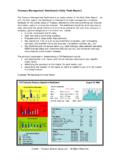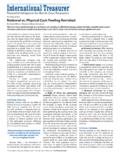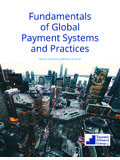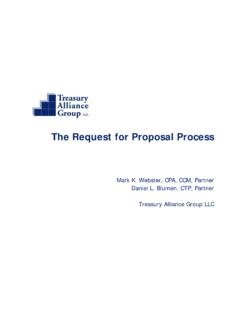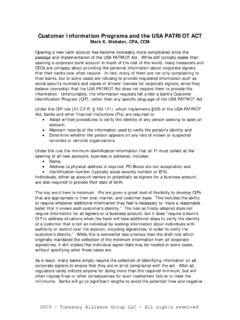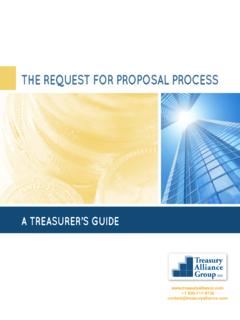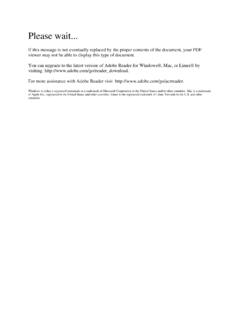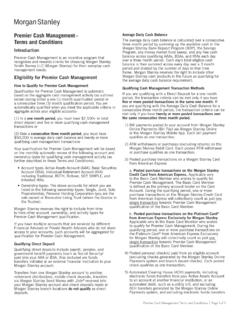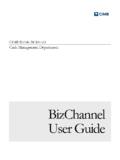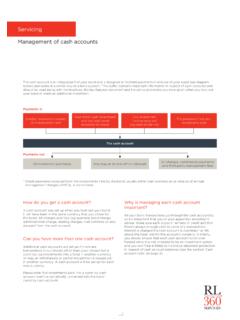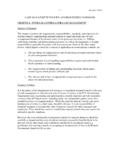Transcription of Cash Management in China - Treasury Alliance Group
1 Cash Management in China Introduction Managing cash in China is challenging for reasons that include a strict but sometimes difficult to interpret regulatory environment, a rapidly developing financial infrastructure and evolving commercial practices. Coupled with government concerns surrounding social stability, economic prosperity and political control the cash Management environment is complex. Some of the critical cash Management issues are: Collections China s size and expanding commercial centers mean that customer locations and banks may not match a company s geographic footprint.
2 There is also a strong reliance on paper instruments because of tradition and their use in information capture for cash application. Payments Tradition, tied to the company chop as proof of payment helps support the popularity and prevalence of paper-based instruments. And cash is still a commonly used and accepted means of payment. Banking There is still a strong reliance on state-owned institutions due to their sheer number of branches. Local government entities will often dictate that a company maintain an account at a specified bank for local tax payments.
3 And despite changes opening the banking market further to foreign banks their presence in the market is still so small that it is a necessity to use local banks. Regulatory Regulations may be issued from a central authority such as the PBOC (People s Bank of China ) or SAFE (State Administration of Foreign Exchange), but interpretation and execution of these regulations varies between provincial authorities and banks. This article will address many of these issues which arise in managing cash effectively in one of the world s most rapidly expanding economies.
4 Careful planning, an established relationship with a large global bank, and strong local financial expertise can ease the process. Business Structure and Objectives The basic process of establishing a business presence in China is complex and time consuming. Decisions must be made as to the amount of capital to inject, location of plants or offices and staffing of the local operation. In many cases these decisions are made without consideration of their impact on banking, account setup and cash Management controls. Wherever possible, Treasury should be involved at the front-end to help maintain financial flexibility as the business expands, as changing the business model is not easy to do in China .
5 For example, there is a distinction between a manufacturing company and a trading company a business license will be for one or the other. The license will specify precisely what types of activity can be performed by the company such as make hammers , sell perfume , or undertake research . As the business grows, so do the number of licenses and with this, the challenge of managing cash for multiple legal entities. Often, the business or 1 manufacturing entity is established or built up from a joint venture operation and bank accounts are opened with the Chinese partner s existing banks, branches that are within close proximity to the business, or the general recommendations and experience of local Management .
6 Changing these arrangements can be a huge challenge and can sometimes force companies to accept inefficiencies that wouldn t exist had Treasury been involved from the beginning. Account Requirements The number of accounts, banks used and locations will be based on a variety of factors and there is no single bank account structure that can be recommended. Local and foreign banks tailor their recommendations to the specific client situation. Accounts can be maintained in both foreign and local currency but there are significant restrictions based on the residency status of the account owner.
7 Companies will need to maintain several banks accounts, most likely with a combination of indigenous and foreign banks. The following grid illustrates the basic account types and their purpose. Account Type Purpose Comment RMB Basic Mandatory: Can handle all transactions but cash and payroll transactions can only be done through a basic account This is often a local bank close to a company's office. Only 1 basic account per legal entity RMB General Optional: Can handle all transaction types except cash and payroll Limited to one account per branch.
8 Many multinationals use a large foreign bank Tax Account For payment of local provincial taxes Local governments often dictate the bank for this purpose, en example of convention trumping regulation RMB Special For foreign owned enterprises or Joint Ventures only Used only for corporate payments; cash transactions are not permitted Foreign Currency Capital For investment into China Single purpose account primarily used for capital injection Foreign Currency Current For all collections/payments in the designated foreign currency Similar to a Basic Account Each legal entity is likely to have at least two bank accounts and perhaps as many as five.
9 2 Banking Structure The Chinese banking system has seen considerable change over the past 18 months. The four large state-owned banks (Industrial and Commercial Bank of China , Agricultural Bank of China , Bank of China and China Construction Bank) still handle the bulk of local commercial transactions. The privatization of these and other indigenous banks has been underway for some time and many foreign banks now have an ownership stake in these local institutions. In the near term this will have no impact on their cash Management capabilities.
10 A major change impacting multinational companies is that, effective December 2006, the banking system was further liberalized, and now foreign banks can offer RMB accounts throughout the country wherever they have a branch. (This was previously restricted to 18 cities.) Theoretically, this allows the foreign banks to compete directly with the local Chinese banks until you look at a map and begin to understand the limited reach of foreign banks in comparison to indigenous banks. Also, opening a branch is time consuming and expensive.
